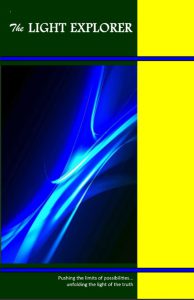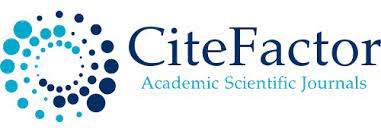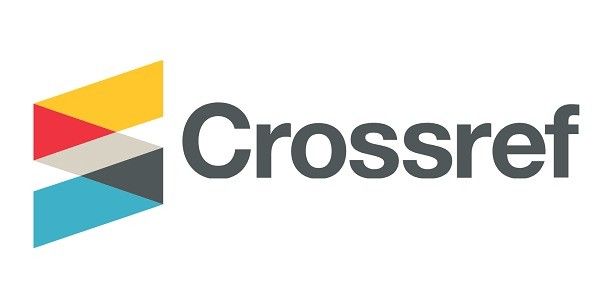Guidelines for Authors (GFA)
Online submission of manuscript is now mandatory for all types of paper.
Please prepare your manuscript following the instructions for authors given below before submitting it online at https://www.thelight-explorer.com/. If submission is completed successfully, a paper ID will be allocated to you and an e-mail acknowledgement will follow. All subsequent correspondence should be sent to the Editor-in-chief, Dr. Jesus B. Pizarro, at editor.thelightexplorer@gmail.com.
Required files
Manuscripts must be in Microsoft Word format only.
Preparation of Manuscripts
Manuscripts should be in English and written in a concise, straightforward style. Authors not fluent in English are advised to have their manuscript checked by a colleague with a good command of the language. The manuscript should present scientific findings which are essentially new and which have not been published or submitted for publication elsewhere.
- Format:
Prior to submission, authors who believe their manuscript would benefit from professional editing are encouraged to use language-editing and copyediting services. Obtaining this service is the responsibility of the author and should be done before initial submission. A template (download) is available to guide authors in the preparation of the manuscript.
- Length:
Although there is no page limit for a Regular Paper, it is strongly suggested that a complete manuscript be no less than 5 pages and no more than 25 pages (10 pt, double-spaced, including figures, tables, and references).
- Sections of Manuscript:
Articles should be organized into the following sections:
Research Articles – Article Title, Authors’ names and institutional affiliations, Abstract and Keywords, Introduction, Materials and Methods, Results, Discussion, Conclusions, Acknowledgements (if any), Statement of Competing Interests, List of Abbreviations(if any), References
3.1. Title (20 words or less)
The title should accurately, clearly, and concisely reflect the emphasis and content of the paper. The title must be brief and grammatically correct. Titles do not normally include numbers, acronyms, abbreviations or punctuation. They should include sufficient detail for indexing purposes but be general enough for readers outside the field to appreciate what the paper is all about. The title should not be more than 20 words in length.
3.2. Authors’ names and institutional affiliations
This should include the full author names (with no titles or qualifications), institutional addresses (Department, Institute, City, Post/Zip code, Country), and email addresses for all authors. Authors and affiliations must be linked using superscript numerals. The corresponding author should also be indicated.
3.3. Abstract and Keywords
The abstract should be comprehensive but concise consisting of no more than 300 words and should be structured to give a brief introduction to the study, main findings of the study, conclusions drawn from the study and their significance. Do not include references, headings, and non-standard abbreviation. While the abstract is conceptually divided into three sections (Background, Methodology/Principal Findings, and Conclusions/Significance), please do not apply these distinct headings to the abstract within the article file. Please do not include any citations and avoid specialist abbreviations. Also provide 5 carefully chosen keywords.
3.4. Introduction
Here authors should make a case for the study, providing a brief literature survey (avoid citing literature older than ten years, unless absolutely necessary) and background to the study, research objectives/problem statement, and the significance of the presented research.
3.5. Materials and Methods
Here the author discusses the research design, the research participants, the data collection tools and data analysis. In case the design is experimental, the experimental procedures should be given in sufficient detail to allow these to be replicated by other researchers. The source of the various reagents and materials used in the study should be given, where possible.
3.6. Results
The results section should provide details of all the results that are required to support the conclusions of the paper. There is no specific word limit for this section, but details of experiments that are peripheral to the main thrust of the article and that detract from the focus of the article should not be included. The section may be divided into subsections, each with a concise subheading. Large datasets, including raw data, should be submitted as supporting files; these are published online alongside the accepted article. We advise that the results section be written in past tense.
3.7. Discussion
This section should present comprehensive analysis of the results in the light of any previous research. Discussion may also be combined with results.
3.8. Conclusions
Conclusion section should bring out the significance of your research paper, show how you’ve brought closure to the research problem, and point out remaining gaps in knowledge by suggesting issues for further research.
3.9. Acknowledgements
The authors should first acknowledge the source of funding for the research presented in their article followed by any personal credits.
3.10. Statement of Competing Interests
Include an explicit disclosure of any competing interests (financial or others) that may have influenced the study or the conclusions drawn from the study. If none, state ‘the authors have no competing interests’.
3.11. List of Abbreviations
Define all non-standard abbreviations in parenthesis on their first appearance in the text as well as provide a list. Standard abbreviations need not to be included in the list.
3.12. References
The reference list appears at the end of your paper. It provides the information necessary for a reader to locate and retrieve any source you cite in the body of the paper. Each source you cite in the paper (with the exception of personal communications) must appear in your reference list; likewise, each entry in the reference list must be cited in your text. Only published or accepted manuscript should be included in the reference list. Papers that have been submitted but not yet accepted should not be cited. Limited citation of unpublished work should be included in the body of the text only as “unpublished data”.
Citation
As you write your report, you will cite your references. A citation to a reference in the body of the text is indicated by a bracketed number corresponding to the reference number in the References section. Example: During high stress periods, individuals should focus on the situation-specific tasks rather than rely on general knowledge structures. [1]
Reference Formats
GENERAL INSTRUCTIONS
A complete reference should contain the name(s) of the author(s) and/or editor(s), the title of the article, the name of the book or conference proceedings where appropriate, and bibliographic information about the article such as the name of the publisher, the city of publication, and the page numbers. The basic concept is that the reference should be sufficiently complete so that the reader could readily find the reference and can judge the authority and objectivity of the reference.
All author names appear as Last name, Initials. For example, if Kirsten Patrick is the primary author and Alice M. Agogino is the second author, the correct appearance of the author names would be: Patrick, K., and Agogino, A.M.
Books
Standard format
Authors, Title (in italics), Publisher, City of Publication, Year of Publication, page numbers (if appropriate).
Example:
1. Fogg, B.J, Persuasive technology: using computers to change what we think and do, Morgan Kaufmann Publishers, Boston, 2003, 30-35.
Journal articles
Standard format
Authors, “Title of the article”, Journal name (in italics), Volume (Issue), Pages, Month Year.
Example:
Hirsh, H., Coen, M.H., Mozer, M.C., Hasha, R. and Flanagan, J.L, “Room service, AI-style”, IEEE intelligent systems, 14 (2). 8-19. July 2002.
Conference Proceedings
Standard format
Authors, “Title of the article”, in Title of conference (in italics), Publisher, Pages.
Example:
Leclercq, P. and Heylighen, “A. 5,8 Analogies per hour: A designer’s view on analogical reasoning”, in 7th International Conference on Artificial Intelligence in Design, Kluwer Academic Publishers, 285-303.
E-Books
Standard format
Authors, Title of E-book (in italics), Publisher, Date of original publication.
[Format] Available: Source.
Example:
- Eckes, The Developmental Social Psychology of Gender, Lawrence Erlbaum, 2000.
E-journal
Standard format
Authors, “Title of Article”, Title of Journal (in italics), Volume (Issue), pages, month year.
[Format] Available: Database Name (if appropriate), article number (if given), internet address. [Accessed date of access].
Example:
A. Altun, “Understanding hypertext in the context of reading on the web: Language learners’ experience”, Current Issues in Education, 6(12), July 2003. [Online].
[Online]. Available: http://cie.ed.asu.edu/volume6/number12/. [Accessed Dec. 2, 2004].
3.13. Tables
The table title should be concise, no more than one sentence. The rest of the table legend and any footnotes should be placed below the table. Footnotes can be used to explain abbreviations.
Tables must be cell-based, such as would be produced in a spreadsheet program or in Microsoft Word. Do not provide tables as graphic objects. Tables must be no larger than one printed page (7inches x 9.5inches). Larger tables can be published as online supporting information. Bold and italics formatting will be preserved in the published version; however, more extensive formatting will be lost. Do not include color, shading, lines, rules, text boxes, tabs, returns, or pictures within the table.
All tables must be numbered consecutively (in Arabic numbers). Table headings should be placed (centered) above the table. Place tables as close as possible to where they are mentioned in the main text. All Tables should be referred to in the text as Table 1, Table 2, etc.
3.14. Figures
Figures should be as small and simple as is compatible with clarity. The goal is for figures to be comprehensible to readers in other or related disciplines, and to assist their understanding of the paper. Unnecessary figures and parts (panels) of figures should be avoided: data presented in small tables or histograms, for instance, can generally be stated briefly in the text instead. Avoid unnecessary complexity, coloring, and excessive detail.
All illustrations should be original drawings or photographic prints of originals. Photographs should be glossy prints. Photocopies are often not good enough and should be avoided. All illustrations must be numbered consecutively, as Fig. 1, Fig. 2. Center figure captions beneath the figure. Do not assemble figures at the back of your article, but place them as close as possible to where they are mentioned in the main text. No part of a figure should go beyond the typing area.
3.15. Figure Legends
The aim of the figure legend should be to describe the key messages of the figure, but the figure should also be discussed in the text. Each legend should have a concise title of no more than 15 words. The legend itself should be succinct, while still explaining all symbols and abbreviations. Avoid lengthy descriptions of methods.
3.16. Equations
Number equations consecutively. Equation numbers, within parentheses, are to position flush right, as in Eq. (1) or equation (1), using a right tab stop.

(1)
Note that the formula is centered using a center tab stop. Be sure that the symbols in your formula have been defined before or immediately following the equation. Use “Eq. (1)” or “equation (1)”, not “(1)”, in the sentences. Notation. Notation must be legible, clear, compact, and consistent with standard usage. In general, acronyms should be defined at first use.
Variables and Vectors. Set single-letter variables in italics (e.g. m). Set vectors in boldface (e.g. E). Derivative “d,” abbreviations, and multi-letter identifiers should be set in roman (plain) type (e.g. cos, ∫…dx).
- Submission self-checklist
Before submitting your manuscript online, please check that all style and format requirements have been carefully followed.
*English spelling and punctuations are used throughout the paper.
*The paper is original, not submitted anywhere else.
*The length of the paper is commensurate with content.
*The title and headings are brief and catchy.
*Names and affiliations (including postal codes) of all authors are correct and complete.
*Figures are of sufficient quality for printing, with clear resolution of detail.
*Abstract and keywords are provided.
*All table captions and figure legends are provided.
*Tables/Figures are properly placed and numbered with brief titles/ captions.
*References are in standard style.











